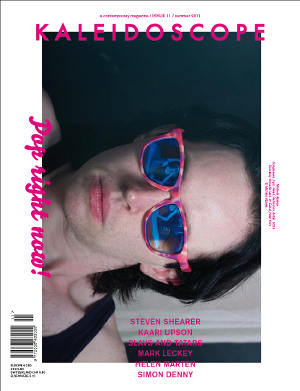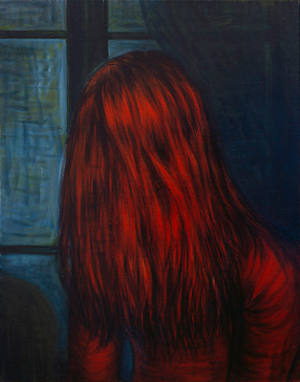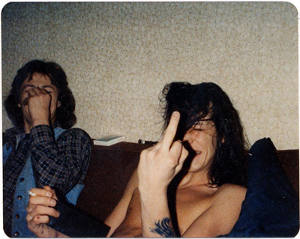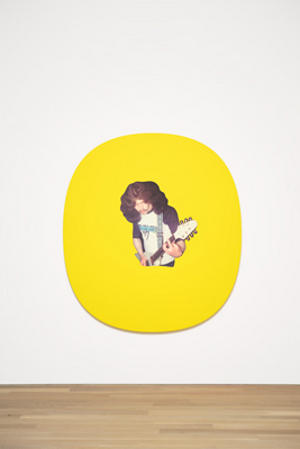L'edicola digitale delle riviste italiane di arte e cultura contemporanea
Kaleidoscope Anno 3 Numero 11 estate 2011
Post-Warholian mourners
Dieter Roelstraete

a contemporary magazine

HIGHLIGHTS:
Steven Shearer by Dieter Roelstraete;
Slavs & Tatars by Carson Chan;
Kaari Upson by Quinn Latimer;
Alina Szapocznikow by Chris Sharp;
Greg Parma-Smith interview by Nicolas Guagnini.
MAIN THEME: POP RIGHT NOW:
Roundtable with Bettina Funcke, Massimiliano Gioni, John Miller, moderated by Joanna Fiduccia, with a postscript by Boris Groys, and artworks by Darren Bader; Justin Bieber by Francesco Spampinato;
Rashid Johnson interview by Alessio Ascari; T
he Dark Side of Hipness Mark Greif and Richard Lloyd in conversation.
MONO: MARK LECKEY:
Lost in the Supermarket by Barbara Casavecchia;
The Browser Is a Portal by Isobel Harbison;
Special Project by Mark Leckey;
Art Stigmergy interview by Mark Fisher.
COLUMNS:
PIONEERS: Morgan Fisher by Simone Menegoi;
FUTURA: Helen Marten interview by Hans Ulrich Obrist;
MAPPING THE STUDIO: Simon Denny by Luca Cerizza;
CRITICAL SPACE: Douglas Coupland interview by Markus Miessen;
ON EXHIBITION: Jeff Koons' "The New" by Paola Nicolin;
LAST QUESTION: And What About Pop Music? answer by Scott King.
Torbjørn Rødland
Hanne Mugaas
n. 22 autunno -inverno 2014
John Armleder
Andrea Bellini
n. 21 estate 2014
Voiceover: Under the skin
Shama Khanna
n. 20 inverno 2013-2014
Yang Fudong
Davide Quadrio e Noah Cowan
n. 19 autunno 2013
Massimiliano Gioni
Francesco Manacorda
n. 18 estate 2013
John Currin
Catherine Wood
n. 17 inverno 2012-2013

Courtesy: Stuart Shave/Modern Art, London
Galerie Eva Presenhuber, Zurich
Galleria Franco Noero, Turin
Gavin Brown, New York

Courtesy of: Stuart Shave/Modern Art, London
Galerie Eva Presenhuber, Zurich
Galleria Franco Noero, Turin
Gavin Brown, New York

Private Collection, London
Courtesy: Galerie Eva Presenhuber Zurich
© Steven Shearer
STEVEN SHEARER, the representative of Canada at this year’s Venice Biennale, practices a dazzling pictorial experimentation engaged with a dense array of historical styles, from Impressionism to Expressionism, Fauvism, and Symbolism, while exploring the codes of suburban American pop culture.
Through no fault or design of my own, a chance visit to Minneapolis provided just the right inspirational occasion for jotting down a few thoughts on the new and not-so-new work of Vancouver-based artist Steven Shearer (b. 1968), whose drawings, paintings, and sculptures will occupy the Canadian Pavilion during this summer’s Venice Biennale. The occasion in question was an exhibition titled “The Mourners,” which I was fortunate enough to see at the Minneapolis Institute of Art. The exhibition’s titular grievers are a group of thirty-eight small alabaster sculptures, made in the fifteenth century by some of Europe’s finest stone carvers to adorn the graves of the Dukes of Burgundy: a procession of mournful, dejected looking monks, many with their hoods pulled over their contorted faces, languorously shuffling in and out of the labyrinthine structure (meant to evoke the entrails of a medieval Carthusian cloister) that forms the pedestal on which the life-size sculpted effigies of the ducal deceased lie enshrined.
Although I first got to know these extraordinary (and extraordinarily expressive) sculptures through a book that was given to me as a birthday present by another artist friend, upon seeing this morbid sepulchral extravaganza, my thoughts quickly wandered off to Steven Shearer’s studio—and they did so not just because “mournful,” “dejected,” “contorted,” “heretical,” “languorous,” “morbid,” and “sepulchral” are adjectives that are often (and, it should be added, often too easily) applied to Shearer’s own work.
The first thing that may strike the casual observer of Shearer’s work is his facility with the overdetermined codes of suburban American pop culture: ’70s teen-idols Leif Garrett and Shaun Cassidy on the one hand, and the depressive proletarian folk art of heavy/speed/ trash/death/black etc. metal (“mourners”) on the other hand. The popular appeal of the oftentimes gigantic jpeg mosaics for which Shearer is perhaps best known—huge kaleidoscopic assemblies of pictures and photographs scavenged during long hours of online image-trawling— has partly to do with the ludic dimension of what could be called their “quiz” effect: trying to figure out who’s who, and which black metal folk hero is being feted. Indeed, for a passably informed viewer such as myself, these particular works’ undeniable entertainment value is clearly rooted in the thrill of recognition, a key ingredient in all post-Warholian variations on the canonical Pop formula of the high colliding with the low. Recognizing the lead singer of Obituary, the lead guitarist of Cannibal Corpse, the founder of Mayhem, or the drummer of Morbid Angel (Pete “The Feet” Sandoval in Pete, a painting from 2001) in those hallowed spaces of art where, you’re convinced, no one else really knows what or whom he or she is looking at—this, in a nutshell, constitutes the two-pronged essence of Pop’s secret pleasure: pop-cultural literacy on the one hand, and a conspiratorial sense of insider knowledge on the other. Yet even though the cultural specificity of this source material should not be minimized, it shouldn’t be overrated either: overall, the online discovery of an image of, say, the dead singer of Norwegian black metal pioneers Mayhem lying in a pool of blood and brain tissue often only marks the beginning of the transformative imaging process around which so much of Shearer’s art revolves—an art of the metamorphosis of certain obscure pop-cultural references (primarily by way of recourse to self-consciously old-fashioned imaging techniques) rather than their straightforward celebratory staging.
I have been a frequent visitor to Shearer’s studio for a number of years now, and much of the excitement these visits occasion is connected with two interlocking questions: What nineteenth-century art books are lying around the studio today? And, in which style will today’s version of, say, “that guy out of Emperor” or “that guy out of Bathory” be rendered? For the last couple of years, Shearer has concentrated on no more than a handful of portraits, but over time, these motifs—grainy pictures of “guys” out of Mayhem, Emperor, Bathory— have become the test site for some dazzling pictorial experimentation, much of it conceived in dialogue with canonical or not-so-canonical art history. “The guy out of Emperor” shows up in Davos (2007) as well as in a painting titled Waiting II (2006), while “the guy out of Bathory” appears in Smoke (2005), The Convalescent (2006), and Drag (2007). (Androgynous imagery, seemingly at odds with the machismo of the Metal scene, has been strongly present in much of the artist’s output of the last decade; it is only very recently that decidedly feminine figures—along with an ostentatious, gleeful eroticism—have started to make an appearance in the work.) Indeed, rather than guessing where a certain image was taken from—the slightly tired formula of Neo-Pop, and one of the cornerstones of the regime of hyper-referentiality that holds so much contemporary art in its grip—it is the work’s elegant engagement with a dense array of historical styles that makes for much of the viewing pleasure, ranging from Northern European Renaissance drawing (Breughel, Dürer, and Holbein in Shearer’s drawing series “Longhairs” in particular) to late nineteenth-century Symbolist and post-Impressionist painting or early twentieth-century German Expressionism and Fauvism (Edvard Munch is a perennial favorite of Shearer’s, as are James Ensor and Henri Toulouse-Lautrec). The doubly refreshing effect of Shearer’s work, then, is related, first of all, to the fact that the iconographic reference (“which metalhead?”) in the end doesn’t matter much—its treatment does—and second of all, to the choice of pictorial styles in which these references are treated, further deepening the distance between the Urbild and its outcome.
It is difficult to single out a single programmatic work from such a varied corpus, but a large-scale painting titled 1900 (2006) comes pretty close: it depicts a shirtless figure, hair hanging down so as to obscure his facial features, seated in what looks like a fin-de-siècle train carriage—“1900” denoting the historical moment in which the artist, stylistically at least (this is the one painting that most clearly demonstrates Shearer’s fondness of Munch), appears to be most at ease. The figure’s actual provenance having been reduced to little more than a faint echo, 1900 appears thankfully free from the stranglehold of referentiality—that is to say, artist and viewer alike are free to enjoy the image as image, rendered in a style borrowed from the long history of image-making.
To conclude, one last look at a despondent figure (a “mourner”) in another painting that may perhaps be singled out as singularly programmatic, if only because it is the only one (to my knowledge) to include a reference to the geographic circumstances of Shearer’s upbringing and youth, leading one to speculate whether the lone figure in this painting is perhaps the artist himself. The work is titled PoCo Trail (2006), an allusion to Port Coquitlam, the working-class suburb of Vancouver where Shearer grew up, and it is one of a handful of paintings I remember seeing weave its way through a number of different painterly styles in the studio, from Impressionist to Expressionist via Fauvist and Symbolist. Modestly sized, it depicts a long-haired blond man in striped trousers. It is uncertain whether he is heading for a forest, or merely content to stand at its edge. The bright red trees of the forest awaiting him are rendered in broad, crude strokes reminiscent of Ernst Ludwig Kirchner, while the yellow sky in the distance appears haunted by the restless, tormented spirit of Emil Nolde. Once again, the identity of the figure in the foreground (“which metalhead?”) matters less than the exemplary solitude depicted: Shearer’s peopleless PoCo path, clearly, is the one less traveled by.
DIETER ROELSTRAETE is an editor of Afterall journal and works as a curator at MuHKA, Antwerp, where he recently organized “Liam Gillick and Lawrence Weiner: A Syntax of Dependency.” He lives in Berlin.


